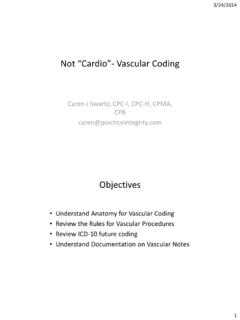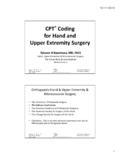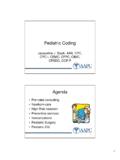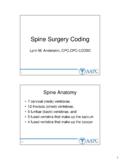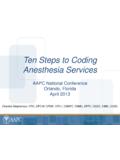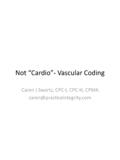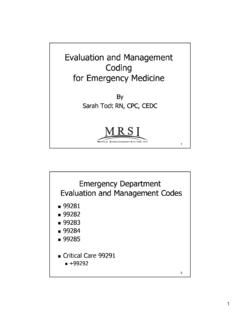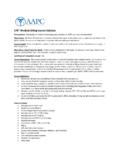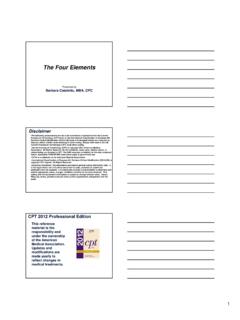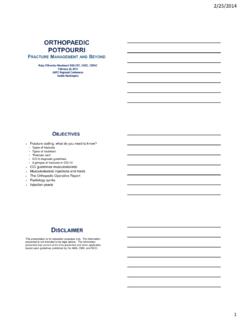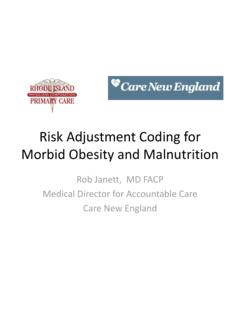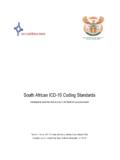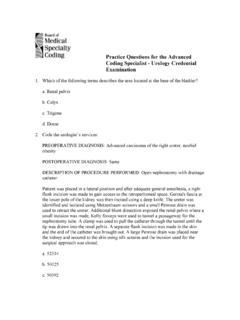Transcription of CRC™ Preparation Course Syllabus - AAPC
1 CRC Preparation Course Syllabus Prerequisites: Knowledge of medical terminology and anatomy (or AAPC courses) strongly recommended. Clock Hours: 40 (Note: 40 clock hours accounts only for time spent in the online Course , and does not include time spent outside the Course or study time. Study time will vary widely per individual.) Course Length: To be completed at student s own pace within a 3-month period or less. Enrollment date begins at date of purchase. Monthly Course extensions may be purchased. Class Hours: Days/Times Per Week: Online Course , independent self-study, no classroom meetings; student may login to Course at their own time schedule, no specific login times.
2 Certificate of Completion Issued: Yes CEUs: 30 CEUs upon completion (AAPC certified prior to enrollment; some certifications excluded see AAPC website for more details.) Course Description: The student will learn principles of risk adjustment and accurate diagnosis coding . In addition, there will be discussion of predictive modeling, financial impact of risk adjustment coding , documentation challenges, official diagnosis coding guidelines, and diagnosis coding in ICD-10-CM. This Course is recommended for anyone who is currently working in risk adjustment or wants to learn risk adjustment coding .
3 Course Objectives: Define different models of risk adjustment (HCC, CDPS, HHS-ACA, Hybrid) Understand predictive modeling and its impact on risk adjustment Explain risk adjustment impact on financial matters Apply official ICD-10-CM coding guidelines Identify elements of the medical record Identify documentation deficiencies for diagnosis coding Understand the most common conditions in risk adjustment and how to properly code in ICD-10-CMCourse Content: Pharmacology Risk Adjustment ModelsoHierarchal Condition Categories (HCC)oMedicaid Chronic Illness and Disability Payment System (CDPS)
4 OHybrid models Predictive Modeling & Quality of CareoPredictive modeling impactoSuspect logicoQuality of careoStar ratings Risk Adjustment and Financial MattersoHCC RAF scoreoFinancial impact based on coding ICD-10-CM coding Guidelines Diagnosis Documentation and CodingoCommon errors in diagnosis codingoElements of the medical record Documentation BarriersoSignaturesoInsufficient documentationoRisk Adjustment Data Validation (RADV) processoOfficial diagnosis coding guidelines Frequently coded conditionsoAcute vs. Chronic conditionsoDifferential DiagnosisoRisk Factors and ComorbiditiesoAnginaoArtificial OpeningsoBMI and ObesityoCardiac Conduction DisordersoCardiomyopathyoCVAoCKD, Dialysis.
5 And AV FistulaoCOPDoComplications of CareoCongestive Heart FailureoCor PulmonaleoDVToDementiaoDepressionoDiabet es and Secondary DiabetesoEpilepsy & ConvulsionsoGERDoHepatitis & CirrhosisoHIVoHypercholesterolemiaoHyper tensionoHypothyroidismoKlebsiella PneumoniaeoMalnutrition & CachexiaoMyocardial InfractionoNeoplasmsoNeuropathyoPneumoni aoPulmonary EmbolismoPulmonary HypertensionoRespirator/Ventilator StatusoSepticemia & SepsisoUlcers & WoundsoVaricose VeinsoVertebral Fractures Practical ExpertiseoPractical diagnosis coding skills utilizing cases for practical applicationMethods of Evaluation: The instructional methods used include reading assignments, quizzes, practical applications, interactive audio/video lectures, chapter review exams, and a final exam.
6 To receive a certificate of completion, students must successfully complete the Course within the allotted time frame of 3 months or less (monthly extensions may be purchased). Successful Course completion includes: An attempt on all chapter quizzes & practical applications A passing score of 70% or higher on all chapter review exams A passing score of 70% or higher on the final exam An overall final Course score of 70% or higherNo reduced hours in the Course or tuition discount for previous education or training will be granted. Included Reading Material: 1.
7 Medical coding Training: CRC ; AAPC publisher (available online only in PDF format, notextbook will be issued with this Course )Required Code Book (Not Included): 1. ICD-10-CM code book (2020 year), any publisherRequired code book may be purchased through AAPC or any major bookseller. Computer Requirements: High-speed Internet connection with Blackboard supported Operating System & Web browser (see Course Requirements tab at ) Adobe Flash Player; Adobe Acrobat Reader. For best experience, use of a mobile device is not recommended. Course Enrollment Fee: Payment is due in full at time of enrollment.
8 Fees listed do not include any required or recommended textbooks/supplies or computer requirements, which are to be purchased separately by the student. Prices are variable and subject to change, see AAPC website for most current enrollment fees.
